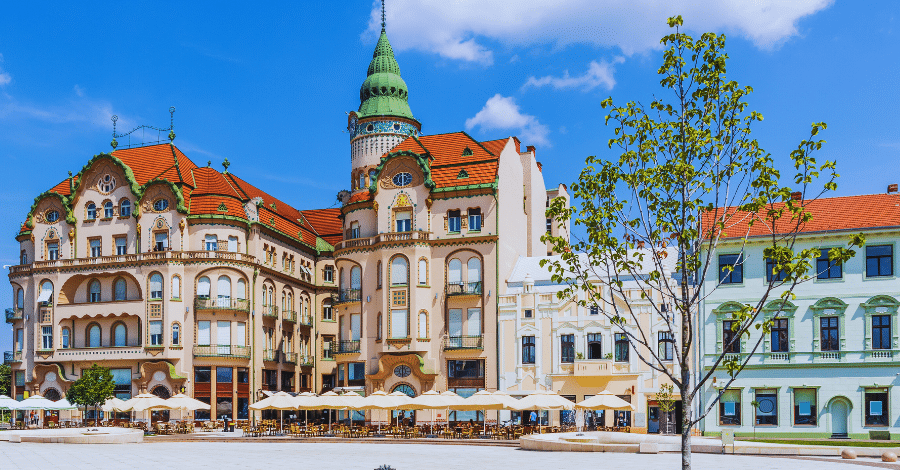If you’re looking for an amazing, less crowded place in Europe to visit this summer, away from the tourist hordes in Italy or the scorching heat of Spain, head over to the incredibly beautiful Transylvania, Romania.
Transylvania is a region in the northwestern part of Romania, easily reachable by car from Hungary, or by international flights into the Cluj-Napoca or Timisoara airports. Oradea and Sibiu also have smaller airports that accommodate some international routes.
Contrary to its reputation, Transylvania is not a scary place at all, it’s actually so different from its Dracula-haunted image. This region is considered the prettiest and most westernized part of Romania.

Long under the Austro-Hungarian occupation in the Middle Ages, Transylvanian cities and towns bear an incredible resemblance to charming Austrian or German towns with a Romanian twist. That era brought over a certain Western character and culture, in contrast to what you might see in the south of Romania, including Bucharest, for instance, where the Turkish and Greek influence are much more potent, while eastern Romania’s Moldova region adopted more of the Russian and Byzantine culture.
Although Transylvania has some idyllic natural wonders, such as the Apuseni Mountains, worth a trip as well, today we’ll take you on a tour of Transylvania’s most charming towns. We’ve listed them such that you can easily plan a road trip to see them all in seven to ten days, for a complete dose of Romanian history, charm and hospitality.
Seven amazing Transylvanian towns for a memorable road trip this summer
1. Oradea
Oradea, located at the edge of the northwestern part of Romania, right after you cross the border from Hungary, is a city of about 200,000 residents, first documented as a city in 1113. Known for its stunning Art Nouveau architecture and thermal springs resorts located in and near the town, it’s a destination that Romanian and foreign tourists are rediscovering.

Oradea has benefited from massive investments in recent years that were used to restore its beautiful Art Nouveau buildings, medieval town squares, several landmarks and parks. As such, the city has been literally transformed from just another place you cross on your way to Hungary, to a fantastic destination to visit and enjoy in its own right. It’s certainly worth a day on your itinerary.

Take on the city on foot and explore its airy town center surrounded by imposing buildings and the adjacent side streets for discovering tiny houses with unique architecture hidden in gardens among greenery and blooming trees.
We also recommend visiting the Oradea Fortress, historic star-shaped fortress with a rich history dating back to medieval times, and the Black Eagle Palace, a stunning Art Nouveau building located right in the center, featuring a beautiful glass-covered passageway and intricate architectural details.
2. Cluj-Napoca
After a three-hour drive west from Oradea, you’ll arrive in Cluj-Napoca. Often simply called Cluj, this is a charming university town situated in the heart of Transylvania, Romania. This historic city is home to around 350,000 residents if you don’t count college students, making it the fourth largest city in the country.

Cluj-Napoca traces its origins back to Roman times, officially founded as a city in 1213, and relics of its rich history are found throughout the city. Today, it is a modern, well-maintained city known for its vibrant student population, IT business scene and dynamic cultural life.
For an authentic European experience, explore the town’s central streets by day, admire the simple clean beauty of St Michael Church and the understated architecture of the surrounding buildings while enjoying some delicious gelato. Then take a breather in Central Park where you can sit on a bench under beautiful mature trees by the lake to admire the swans.

To truly fall in love with Cluj, go out in the evening, when its Cosmopolitan vibe comes alive. During summer evenings, you’ll see kids running around in Union Town Square while their parents enjoy a drink and a meal on the nearby restaurant patios. For a youthful buzzing crowd, head over to Museum Square for more dining options in a Vienna-esque atmosphere.
3. Alba Iulia
Just an hour and a half drive south from Cluj, Alba Iulia is another famous historic town in Transylvania worth a visit. With a population of around 65,000, it is smaller than many of the country’s major cities but holds great historical significance. Founded by the Romans in the 2nd century AD, Alba Iulia is famed for its star-shaped fortress named Alba Carolina and its role in the unification of Romania in 1918.

In fact, Alba Carolina Fortress (or “Cetatea” as the Romanians call it) is now the coolest hangout spot in town, dotted by cafes with outdoor sitting and parks. Enjoy a day of history and relaxation in Alba Iulia both inside the fortress and around the outer walls, where you’ll find tranquil walking alleys and more treasures to discover, such as a little rose garden and a centuries’ old library. The locals call these “the ditches”.

The fortress is anchored by two incredibly beautiful cathedrals. The Roman Catholic Cathedral of Saint Michael is one of the oldest and most important cathedrals in Romania, featuring stunning Gothic architecture and a rich history dating back to the 13th century.
The second is the Coronation Cathedral, officially named the Orthodox Cathedral of the Reunification, this grand cathedral was built to commemorate the unification of Romania in 1918. It is also known as the Coronation Cathedral because it was the site where King Ferdinand and Queen Maria were crowned as rulers of Greater Romania in 1922.
4. Sibiu
Sibiu, a charming small city in central Romania, lies in the historical region of Transylvania, about an hour drive from Alba-Iulia. It has a population of around 150,000 people. Founded by Saxon settlers in the 12th century, Sibiu is celebrated for its well-preserved medieval architecture and vibrant cultural scene, having been designated a European Capital of Culture in 2007.

The Saxons have left their mark on the town’s look and feel, making it rather unique in the country. Examples of the town’s German heritage can be found in the Gothic-style Lutheran Cathedral of St Mary, located in Huet Square.

The Brukenthal National Museum is a palace with an elegant façade and richly decorated interiors, the Council Tower in the Great Square, the House of the Arts in the Small Square, and the Stair Passage connecting the Upper Town and Lower Town.
5. Timișoara
For a complete circle around Transylvania, head back west to Timisoara, two and a half hours drive from Sibiu. Located in the western part of Romania, in a province called Banat, near the borders with Hungary and Serbia, Timișoara is a significant cultural and economic center.

With a population of about 350,000 people, it ranks as one of Romania’s major cities. Timișoara was first documented in 1212 and is renowned for its architectural diversity and its role as the starting point of the Romanian Revolution of 1989.
Timisoara is a gorgeous city that’s often overlooked by both foreigners and Romanian. We couldn’t recommend it more, as it a great city break destination as well as one of the best affordable places to live in Europe. You can easily spend a weekend here and you won’t get bored. Union Square (Piața Unirii) is vibrant and colorful large square surrounded by baroque buildings, including the Roman Catholic Cathedral and the Serbian Orthodox Cathedral. You could sit here all day to admire the stunning buildings and the people walking by, and you won’t be disappointed.

A landmark worth mentioning is the Huniade Castle – the oldest building in Timișoara, this historic castle now hosts the Banat Museum, showcasing regional history and archaeology. Then there’s the beautiful Bega river, with cheap river taxis and endless green parks running alongside it. Stop and enjoy local craft beer and Romanian cuisine at one of the riverside cafes for a true Timisoarean experience.
6. Brașov
A little further to the east is the famous mountain city of Brasov, located over four-hour’s drive from Timisoara, but worth the trip. Nestled in the heart of Romania, in the very central part of the country, Brașov is surrounded by the imposing Carpathian Mountains.

This picturesque city has a population of about 250,000 and was founded in 1211 by the Teutonic Knights and Saxon colonists. It is known for its medieval landmarks, such as the Black Church, and its proximity to the famous Bran Castle, often associated with the Dracula legend.
But of course, there’s so much more to Brasov than Dracula. It is arguably one of the most sought-after cities in Romania by tourists thanks to its elevated location and historic beauty.
Boasting famous landmarks such as The Black Church, a Gothic church, renowned for its impressive size, blackened walls from a past fire, and an extensive collection of Anatolian carpets, Brasov also has a few hidden gems to discover.

We recommend the Schei District, a historic neighborhood located just outside the city walls that offers a glimpse into the traditional Romanian way of life. Wander through narrow, winding streets lined with colorful houses, visit the Saint Nicholas Church, a beautiful Orthodox church with frescoes and a serene courtyard, and stop by the First Romanian School Museum to learn about the area’s cultural heritage.
Next, check out one of the lesser-known medieval gates of Brașov, Catherine’s Gate. It was built in 1559 and is the only original city gate to have survived from medieval times. It features a fairytale-like tower with four small turrets and is a charming spot for history enthusiasts.
White Tower (Turnul Alb) and Black Tower (Turnul Negru) are part of Brașov’s old fortifications and offer stunning views over the city. The White Tower, a cylindrical structure, and the Black Tower, named for its blackened walls after a fire, provide a quieter alternative to the bustling city center.
7. Sighișoara
A must see after Brasov is Sighișoara, another picturesque little town in Transylvania that’s a short drive away. With a population of approximately 28,000, it is renowned for its well-preserved medieval citadel with its colorful houses and cobblestone streets designated a UNESCO World Heritage Site. Founded in the 12th century by Saxon settlers, Sighișoara is often referred to as the birthplace of Vlad the Impaler, the inspiration for Dracula.

Sighisoara will offer a small fortress vibe, with local artist and craftsmen selling their handmade treasures on the narrow cobblestone streets alongide charming boutiques and historic sites every step of the way.

A must see is Church on the Hill, a Gothic-style church located atop a hill, offering panoramic views of the town and surrounding area, known for its beautiful interior and historic significance. Other hidden gems in Sighisoara worth hunting down are: The Covered Stairway, Tinsmith’s Tower, The Tailors’ Bastion, The Venetian House and The Shoemakers’ Tower.
From here, you can head back to Cluj-Napoca, which is two hours away by car, to catch a flight back home.

